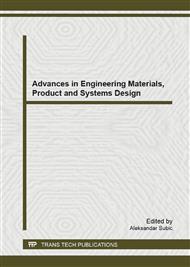p.224
p.239
p.255
p.263
p.277
p.290
p.301
p.312
p.322
Reliability Distribution in Mechanical Systems for Given Reliability and Cost
Abstract:
Modern mechanical systems are required to have high reliability characteristics. To attain them, it is necessary to take particular care (aside from laboratory and in service reliability examinations) of reliability design from the early development stages of a mechanical system. Reliability design for a new system includes an allocation of reliability to system elements which should meet specified requirements. In order to meet certain technical and economic system requirements, a method has been developed using Lagrange multipliers to determine "the best" reliability allocation from the basis of achieving minimum system cost (CSmin) for a specified system reliability (RS). In addition, this method offers the possibility of achieving maximum system reliability (Rmax) for a specified system cost (CS). This paper presents a reliability allocation method allowing the techno-economic requirements imposed on the system to be satisfied in an appropriate way. The method was developed considering some specific factors in the construction of mechanical systems and the relationship between system cost and reliability. In addition, a procedure was developed which permits the determination of "the best" reliability allocation using the multi-criteria ranking method and compromise programming, where system cost and reliability represent the criteria for choosing "the best" solution. The described allocation model was employed in the reliability allocation for an automotive gearbox.
Info:
Periodical:
Pages:
301-311
Citation:
Online since:
January 2013
Authors:
Price:
Сopyright:
© 2013 Trans Tech Publications Ltd. All Rights Reserved
Share:
Citation:


